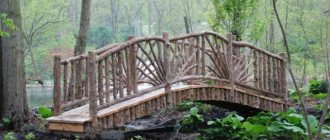Landscape design is a real art that will change the appearance of any plot of land beyond recognition. There are many techniques to create images of different styles. Many people love flower beds, areas with a smooth green lawn, artificial ponds, fountains and waterfalls, and natural alpine slides. Among the diversity was an unusual phenomenon called a dry pond or dry stream.
Option for a dry pond in a summer cottage
The origin of a dry stream and why it is needed
Residents of Japan create a spirit of solitude in their gardens. This atmosphere has a calm effect on the general condition and is not at all annoying. But our people are not accustomed to the laws of the East; we cannot discern in our native places the source of peace.
Of course, the comparisons are incorrect, but nothing can be done. Most summer residents are happy to use Japanese ideas. For example, a dry stream, at first glance, nothing complicated - choose a place, dig a hole, fill it with pebbles, and plant plants on the banks.
But keep in mind that without skills and planning you will end up with an unnecessary and unattractive element in the garden. Let's analyze all the stages of creating a dry stream with your own hands.
How to lay stones along the finished contour?
So, the outline has long been ready, the place has been chosen, the materials for creating the composition are lying and waiting in the wings. And it has come - we are starting construction! Where you have marked the contour with sand, you need to dig a so-called “trough” to a depth of 15 to 25-30 centimeters. The resulting “pit” is leveled with a rake. Of course, you want to see as few weeds as possible on your site. Such a desire is quite understandable and understandable, because they can ruin the appearance of the stream.
- How to build a pond at your own dacha
- How to lay paving slabs yourself
Digging moment
You can safely dig, just remember right away that the walls of the recess should be at an angle of no more than 50 degrees. When digging, throw away the weeds, preferably along with the roots.
Do-it-yourself artificial water flow: step-by-step instructions
The general scheme for building a small reservoir in a natural style is as follows: make two reservoir points, upper and lower. A pump is installed at the bottom of the lower one, which pumps water to the upper point. Water, once at the top, flows down under its own gravity.
- The dimensions and location of the reservoir have already been determined earlier. Now it’s better to check them on the ground. Mark the outlines of the water surface with pegs and stretch a rope between them. Using paint or sand, transfer the outline of the pond to the ground. Also mark the locations of reservoirs, waterfalls, and large stones.
- They dig the lower pit, maintaining the tiering of its slopes. The outer tier is the largest; medium - for the roots of aquatic plants; the inner one is the smallest, for wintering fish. The pit is dug approximately 0.7 m around the perimeter larger than the bowl of the reservoir, and 0.2 - 0.3 m deeper. If the soil around the entire artificial reservoir is too loose, then it is replaced with denser clayey soil to avoid moisture loss. And the land removed from the pit will be useful at the next stage.
- The relief of the area is formed from soil embankments and stones, on which a stream or waterfall will be located. It is advisable to form low sides at the end of each step of the stream: they will prevent the water from completely draining when the pump is turned off. It is better to locate sharp turns of the riverbed on flat areas. At the same stage, the upper reservoir is dug.
Stream with a waterfall in a stone bed
- Each tier of the pit is compacted and sprinkled with several layers of sand and crushed stone, each 10-15 cm thick. After abundant watering, the bottom and walls are compacted again. Layers of sand and crushed stone can be replaced with geotextiles to prevent soil erosion.
- A layer of waterproofing (for example, film) is laid from top to bottom without tension and with a margin of 0.5-0.7 m around the perimeter of the reservoir. The film is pressed with stones, covered with sand, or geotextiles are laid. This layer will become the basis for the decor and protect the film from damage by stones.
- The pump is placed in the finished lower reservoir to a minimum depth of 0.5 m. The pump must not be placed on the bottom, otherwise it may become clogged. Several bricks can be used as an installation site. A hose is connected to the pump, which is drawn along the entire riverbed to the highest point of the artificial source. Also coming from the pump is a waterproofed cable with a plug, the length of which is 5-10 m. Make sure that there is a dry place near the source where you can connect the pump to the network.
- A trial run of the pump is carried out, and if all the desired characteristics of the artificial source are achieved, you can begin to decorate it.
If you don’t want to do waterproofing, you can use ready-made reservoir bowls that are immersed in the prepared base. For a large reservoir, reinforcing the foundation pit will be a mandatory step, since the soil often sags under the weight of water.
Stream decor in oriental style
Pebbles, cobblestones, stones...
The sizes of the material will suit different ones, both small and large, use your imagination here. Large, medium-sized stones, small pebbles in a grayish-blue tint.
When creating a design for a dry stream, you can create a water effect by painting the pebbles with varnish or special blue or azure paint, which shimmers in the dark.
Dig a riverbed
Using twine and pegs or sand, outline the shape of the future riverbed. If your site is equipped with drip irrigation or any utilities are laid in its depths, do not forget to take them into account. Otherwise, forgetfulness and carelessness may deprive you of water or electricity.
Then carefully remove the sod and use a shovel and rake to remove the soil, creating the desired depth. It depends on the purpose (decoration or drainage) and the size of the stones with which you are going to line your bed.
Pond with a bridge
To build a bridge over a stream, only natural wood is suitable. If there is an unused log in the yard, this is what you need.
If you don’t like this option, you can make a crossing with your own hands. Or you can leave it as is and lay stones on the surface.
Decorative bridges on a personal plot
The second element of our idea is the decorative bridge. There are many options for implementing this construction: bridges can be of different shapes, sizes, styles and made of different materials. The main stylistic trends for organizing bridges: country, avant-garde, bridge to nowhere, wild forest and Japanese bridges.
Each style has its own characteristics, based on the concept of the style itself. Country style is characterized by straight shapes with wide railings made of wooden balusters. Stylizing the bridge as an avant-garde, asymmetrical forms born from your imagination are used. The so-called bridges “to nowhere” are becoming increasingly popular - the structure simply breaks off in the middle of the path. If the main idea of the garden is a wild forest, then the design of the bridge should be appropriate, i.e. an ordinary bridge made of boards or two logs thrown across or along a stream. It looks simple and tasteful.
If the stream has an irregular, curved shape, then it is better to locate the crossing in the place where the channel is narrowest.
In addition to its decorative function, the bridge can also serve its intended purpose. For example, you can use it to go to a gazebo or an organized resting place. Often such bridges are built to cross small ravines on the site. The main condition for organizing a bridge is that it must correspond as closely as possible to the concept of the entire garden and become an integral part of the design, and not be a separate structure that is located in an unknown place and for no clear reason.
Landscaping and dry stream
Do not forget that by following the rules and stages of creating a “dried riverbed” you will turn your summer cottage into a piece of paradise with your own hands. Don’t be afraid to take care of the stream, it won’t be difficult, and even interesting - this is for the future.
Of course, the plants will have to be weeded and watered, and insects in the stones and under them must be destroyed. But if you are a responsible and careful gardener, then there will be no problems. Just do everything regularly and don’t leave a trickle unattended.
New Year in the yard: how to beautifully decorate the yard with your own hands!- How to make a modern landscape design with your own hands?
Microgreens at home
Important - a spectacular pond serves not only for decoration, it can also perform some other tasks:
- with its help, storm water will flow smoothly;
- thanks to moisture retention under stones and pebbles, plants do not have to be watered frequently;
- a dry stream in landscape design will become the border between zones in the garden;
- the soil will become invulnerable and will not succumb to erosion;
- the garden will visually acquire larger dimensions.
Instead of small stones, you can use flowering plants. But the stream will be beautiful during flowering.
The right stream for landscaping will create a unique look in the garden, as if it had recently dried up and had water in it. And immediately after the rain, your creation will heal again and sparkle with the reflections of the sun's rays.
Feel free to use your imagination, read the advice of experts and get to work. Carefully study all the stages of creating a stream, purchase the necessary materials and plants. Hurry up, because the warm summer days are quickly passing.
Types of streams: choosing the best option
If you’re unlucky with a natural stream, we’ll try to make an alternative that’s exactly like the real thing, but has a hidden secret, or rather, a secret hidden at the bottom of the reservoir. The role of the secret will be played by a submersible pump, known to all owners of a well or well.
Using a pump, we will create a vicious circle through which the water of an artificial stream will circulate as follows: go up the hose to the source, and then go down the riverbed to a small reservoir
This stream arrangement scheme is universal, but if desired, it can be diversified with one of the proposed solutions:
- waterfall;
- rapids;
- a chain of cascades;
- a small fountain.
In order for the landscape composition to look natural, you will need a difference in height or at least a slight slope, for example, a gentle slope of a hill. Depending on the steepness of the descent - the place where the proposed channel will be located - we will choose the type of stream.
On a small hill it is better to arrange a calm, leisurely stream with smooth bends and quiet murmur. It will be an ideal option if the terrain is absolutely flat, without hills or elevations.
The slope of the channel can be achieved in two ways:
- make a small artificial embankment;
- gradually deepen the bed closer to the mouth.
Do not overdo it when digging the channel and forming its banks - everything should be extremely natural. Nature does not like clear geometry, which means we make smooth bends, an uneven shore line, and uneven bottom filling.
Difficult terrain, inconvenient for planting a vegetable garden or garden, in this case will play into our hands.
A high hill, cliff or steep slope is an excellent opportunity to build an unusual bed of a mountain stream. Unusual because it consists of a series of rapids, riffles, waterfalls and short straight sections
But don’t get carried away with arranging complex structures, otherwise your stream will turn into one big waterfall. The flow of a mountain stream is faster than that of a flat stream, the speed of water movement is higher, the elevation changes are sharper, which means that a more powerful pump will be required.
Calculation of water volume
Due to incorrect calculation of the volume of water, the construction of a ringing stream may fail. It should be taken into account that the pump pumps water over a fairly large distance, which is equal to the duration of the stream. On the way back, the movement of water slows down due to the fact that it goes around stones and plant stems. In addition, water evaporates as it moves. According to some estimates, water in an artificial stream travels only 2 m in 1 minute. For example, when operating a stream 10 m long, 200 to 300 liters of water should be in motion.
Diagram of a stream filled with water
If you decide to independently calculate the volume of water, then take into account the area of the base of the stream, the height of the column of water in the stream and its volume in the hose laid under the stream and supplying water to the highest point of the source and plus the volume of the lower pond.
To ensure smooth operation of the flow, water should be added to it regularly. The need for this is due to water evaporation and ambient temperature.











